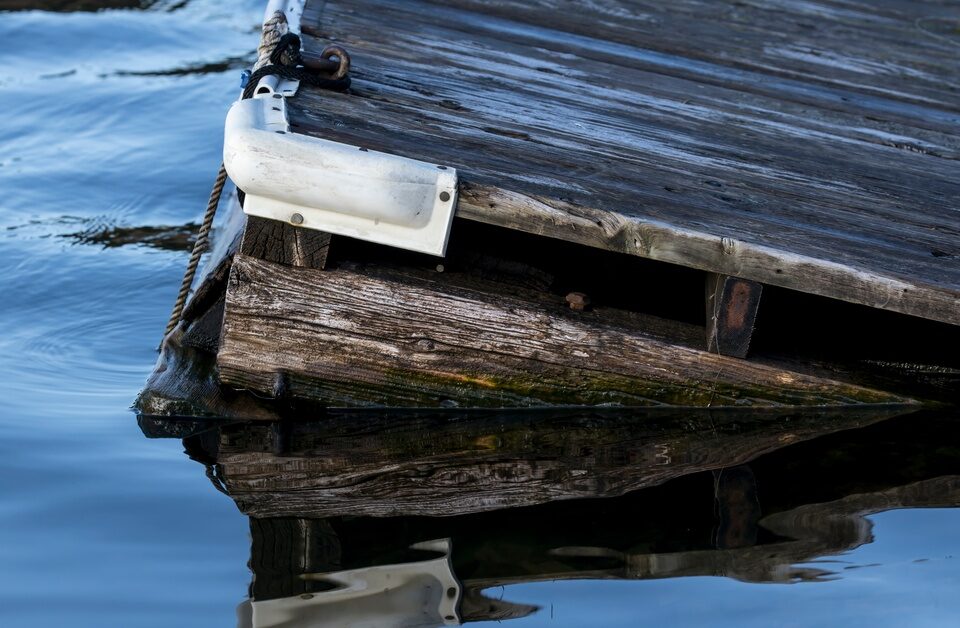When to Use A Floating Dock?
Customers often come to me and say “Hey, I’d like a floating dock for my cottage.” Their request is understandable. Floating docks conjure up nostalgic images of those Adirondack camps and rustic boat launches we all hold dear to our hearts. The emotional appeal aside, when is it right to use a floating dock and when is it just added cost? There are 2 primary scenarios that drive the need for a floating dock: deep water and soft bottoms.
Across the country we have a very diverse variety of water types. From shale and gravel bottoms to slow moving rivers, the way your dock interfaces the water bottom is a critical design point that needs to be addressed early on in the dock selection process. Because the majority of the northern climates get locked up with powerful sheets of ice every winter, to leave a seasonal dock in the water is as good as leaving it out by the road for free. Kiss it goodbye. A slow drive along many frozen lakes will in most years feature at least one humbled homeowner whose dock has been dragged 300 yards into the lake by an unpredictable and ever shifting sheet of ice.
Because of these drastic weather changes, it is necessary to remove a seasonal dock every year. Seasonal docks can typically be broken into 3 main groups: leg docks, roll-in docks, and floating docks.
The first group, leg docks, feature either 2 or 4 leg posts that support a section of dock (typically 4ft wide by 8-20ft long). These docks have some sort of mud feet attached to the bottom of the support pipes which increase the surface area of the support pipes to better distribute the load and prevent the legs from wedging down into the lake bottom. Remember, this dock has to be removed at season’s end so the more that dock settles into the lake bottom, the harder it’s going to be to remove in the fall. Hence, the leg dock is an excellent option for gravel and slightly silty bottoms with no more than 6-8 inches of soft material.
Perhaps the most effortless dock to install and remove is the roll-in dock. These docks typically feature 1 or more set of molded plastic wheels and go in just as the name would suggest. Pick up the end and roll it in like a wheelbarrow. For a lightweight aluminum truss dock or a galvanized steel dock with the decking removed, this is at best a 1 person job and the task can be finished very quickly. However, like the leg dock, if there is a significant layer of soft material, the roll-in dock wheels will sink in the mud and be a real hassle to remove in the fall. Sometimes a 4 wheel drive truck or a winch with steel cable is the only method of removal.
Now for the floating dock. I’ve personally stuck my feet into water bottoms 2 feet off shore that could swallow a man whole. When visiting a customer on a Lake Ontario bay in New York the bottom was so soft and mucky that it was literally underwater quick sand. Wheel a roll-in dock in there and it will never come out again. Pound the posts of a leg dock down with a sledge hammer and watch the ice manipulate your dock with ease every winter. This is the scenario where a floating dock can really shine! Cast aluminum augers are fastened to the bottom of the support pipes. The pipes are locked in an upright position and the dock is floated into place. Once in place, release the pipes from there upright position and auger them into the soft bottom just like a screw.
For the second application where one would use a floating dock we’ll investigate the deep water scenario. All things being equal, a leg dock will almost always be less expensive than a floating dock for the simple fact that dock floats are not being purchased. Floats typically run between $100 and $200 each depending on the supplier and shipping costs. At 2-3 floats per section, this cost ads up quickly. As a rule of thumb, I generally tell my customers that any water depth over 7 or 8ft would begin to dictate a floating dock as a necessity. There are a number of reasons for this. The first is that leg docks often become unstable with long legs. If the water is 7ft deep and the dock is 2ft above the water, all of a sudden your center of gravity is equivalent to a person balancing on the upper steps of a 12ft folding ladder. Not good. There are certain things to mitigate the effects of sway due to a high center of gravity, such as cross bracing, but the physics of the situation suggest you could be looking for trouble.
In addition to the sway issue, it is also worthwhile to note that if a dock is installed in a cold winter climate, it may be necessary to remove and install the dock in the winter to prevent ice damage. Remember, if your dock is is in 7ft of water and you’re only 6ft tall, it could make for a tricky, if not dangerous removal and installation process.
To sum it all up, if your water depth is over 8ft deep or the bottom is softer than warm apple cobbler, a floating dock is likely the way to go. Simply float it into place, drop the support pipes, auger them into the lake bottom and you’re good to go!



